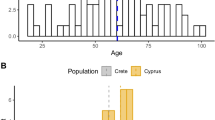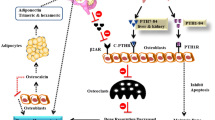Abstract
Harris lines are widely accepted as indicators of physiological stress and provide valuable data for determining the extent and nature of the physiological stress factors acting on a human community. Traditionally, Harris lines are studied in skeletal populations. In the study reported here, data were collected on living children to eventually clarify if stress is basically chronic or acute in nature, if it has a greater impact on children or adults, and if it is correlated with increased rates of mortality. The existence of Harris lines was determined in a sample of 400 children, 210 males and 190 females, randomly selected from those under examination in the radiology services of hospitals. Radiological analysis was used to analyze Harris lines. The age of Harris line formation and variations in the number of lines with age were established to determine at which age the densest line population was present. For this sample, the formation of Harris lines is around 2–3 years of age, in agreement with published literature. It should be taken into consideration that Harris lines are the end result of multiple factors, rather than a single stress factor, and are influenced by an individual’s immune system and resistance to stress.

Similar content being viewed by others
References
Abadan-Unat N (1982) Toplumsal Değişme ve Türk Kadını. In: Abadan-Unat N (ed) Türk Toplumunda Kadın. Araştırma, Eğitim, Ekin Yayınları ve Türk Sosyal Bilimler Derneği, Ankara
Allison M, Mendoza D, Pezzia A (1974) A radiographic approach to childhood illness in pre-Columbian inhabitants of Southern Peru. Am J Phys Anthropol 40:409–415
Arnay de-la Rosa M, Gonzales-Reimers E, Castilla-Garcia A, Santolaria-Fernandes F (1994) Radiopaque transverse lines (Harris lines) in the prehispanic population of El Hierro (Canary Islands). Anthropol Anz 52:53–57
Blumberg MJ, Kerley RE (1966) A critical consideration of roentgenology and microscopy in paleopathology. Human Paleopathology. Yale University Press, New Haven, pp150–156
Buıkstra J, Cook D (1980) Paleopathology: an American account. Annu Rev Anthropol 9:433–470
Byers S (1991) Technical note: calculation of age formation of radiopaque transverse lines. Am J Phys Anthropol 85:339–343
Caffey J (1967) Diseases of bone. Pediatric X-ray diagnosis, 5th edn. Year Book Medical, Chicago, IL, pp789–797 (Baskı)
Cassidy CM (1980) Nutrition and health in agriculturalists and hunter–gathers. In: Jerome NW, Kandel FR, Pelto GH (eds) Nutritional anthropology. Redgrave, South Salem, NY, pp117–147
Clarke SK (1982) The association of early childhood enamel hypoplasias and radiopaque transverse lines in a culturally diverse prehistoric skeletal sample. Hum Biol 54:77–84
Clarke SK, Gindhart PS (1981) Commonality in peak age of early-childhood morbidity across cultures and over time. Curr Anthropol 22:574–575
Drenhaus U (1991) Harris lines, characteristics for identification of individuals. Homo 42:287–299
Erdal YS, Uysal G (1994) İznik Çocuklarında Görülen Bir Patoloji: Harris Çizgileri. Humana, Bozkurt Güvenç`e Armağan. T.C.Kültür Bakanlığı Başvuru Eserleri, Ankara
Garn SM, Hempy HO, Schwager PM (1968) Measurement of localized bone growth employing natural markers. Am J Phys Anthropol 28:105–108
Garn SM, Hertzog KP (1969) A longitudinal test of angular remodeling in the tibia. Am J Phys Anthropol 30:311–314
Garn SM, Schwager PM (1967) Age dynamics of persistent transverse lines in the tibia. Am J Phys Anthropol 27:375–377
Gindhart PS (1969) The frequency of transverse lines in the tibia in relation to childhood illnesses. Am J Phys Anthropol 31:17–22
Goodman AH, Clark GA (1981) Harris lines as indicators of stress in prehistoric Illinois populations. In: Martin DL, Bumsted MP (eds) Biocultural adaptation comprehensive approaches to skeletal analysis, vol 2. University of Massachusetts, Amherst, pp35–46
Goodman AH, Lallo J, Armelagos GJ, Rose JC (1984) Health changes at Dickson Mounds, Illinois (a.d. 950–1300). Paleopathology at the origins of agriculture. Academic, London.
Hughes C, Heylings DJA, Power C (1996) Transverse (Harris) lines in Irish archaeological remains. Am J Phys Anthropol 101:115–131
Hummert JR, Van Gerven DP (1985) Observations on the formation and persistence of radiopaque transverse lines. Am J Phys Anthropol 66:297–306
Hunt EE, Hatch JW (1981) The estimation of age and death and ages of formation of transverse lines from measurements of human long bone. Am J Phys Anthropol 54:461–469
Kağıtçıbaşı, Ç (1981) Çocuğun Değeri, Türkiye’de Değerler ve Doğurganlık. Boğaziçi Üniversitesi İdari Bilimler Fakültesi Yayını, İstanbul
Kağıtçıbaşı, Ç (1982) Türkiye’de Çocuğun Değeri, Kadının Rolü ve Doğurganlığı. Abadan-Unat N (ed) Türk Toplumunda Kadın. Araştırma, Eğitim, Ekin Yayınları ve Türk Sosyal Bilimler Derneği, Ankara
Kurt, İ (1992) Atasözlerinde Aile. Sosyo-Kültürel Değişme Sürecinde Türk Ailesi, 2. T.C. Başbakanlık Aile Araştırma Kurumu, Ankara, (Yayın no 71)
Maat GJR (1984) Dating and rating of Harris lines. Am J Phys Anthropol 63:291–299
Macchiarelli R, Bondiolli L, Censi L, Hernaez MK, Salvadei L, Sperduti A (1994) Intra- and interobserver concordance in scoring Harris lines: a test on bone sections and radiographs. Am J Phys Anthropol 95:77–83
Maresh M (1955) Linear growth of long bone of extremities from infancy through adolescence. Am J Dis Child 89:725–742
Martin DL, Armelagos GJ, Goodman AH, Van Gerven DP (1984) The effects of socioeconomic change in prehistoric Africa: Sudanese Nubia as a case study. Paleopathology at the origins of agriculture. Academic, London
Martin DL, Goodman AH, Armelagos GJ (1985) Skeletal pathologies as indicators of quality and of diet. Gilbert RI Jr, Mielke JH (eds) The analysis of prehistoric diets. Academik, Orlando, pp253–266
McHenry H (1968) Transverse lines in long bones of prehistoric California Indians. Am J Phys Anthropol 29:1–18
McHenry HM, Schulz PD (1975) The association between Harris lines and enamel hypoplasia in prehistoric California Indians. Am J Phys Anthropol 44:507–512
Mensforth RP (1985) Relative tibia long bone growth in the libben and Bt-5 prehistoric skeletal populations. Am J Phys Anthropol 68:247–262
Olivier G (1969) Practical anthropology. Charles C. Thomas, Springfield, IL
Palkama A, Virtama P, Telkka A (1962) Estimation of stature from radiographs of long bones in children. Ann Med Exp Biol Fenn 40:219–222 (Reprint)
Rathbun TA (1987) Health and disease at a South Carolina plantation 1840–1870. Am J Phys Anthropol 74:239–253
Rose CJ (1991) Skeletal database committee. Paleopathological Association, Detroit, MI
Steinbock RT (1976) Paleopathological diagnoses and interpretation bone diseases in ancient human populations. Charles C. Thomas, Springfield, IL
Ubelaker DH (1989) Human skeletal remains: excavation, analysis, interpretation. Smithsonian Institution, Chicago, IL (2. Baskı)
Wells C (1967) A new approach to paleopathology: Harris’s lines. In: Brothwell DR, Dawson WR (eds) Diseases in antiquity. Charles C. Thomas, Springfield, IL
Woodall J (1968) Growth arrest lines in long bones of the Cases Grandes population. Plains Antropol 13:152–160
Acknowledgments
The author thanks the Dr. Sami Ulus Children’s Hospital, Hacettepe University Children’s Hospital, Radiology Department of Ankara University Ibn-i Sina Hospital.
Author information
Authors and Affiliations
Corresponding author
Rights and permissions
About this article
Cite this article
Uysal, G. The Occurrence and Age Distribution of Harris Lines in Turkey. Intl Jnl Anthropology 21, 193–201 (2006). https://doi.org/10.1007/s11599-006-9021-2
Received:
Accepted:
Published:
Issue Date:
DOI: https://doi.org/10.1007/s11599-006-9021-2




